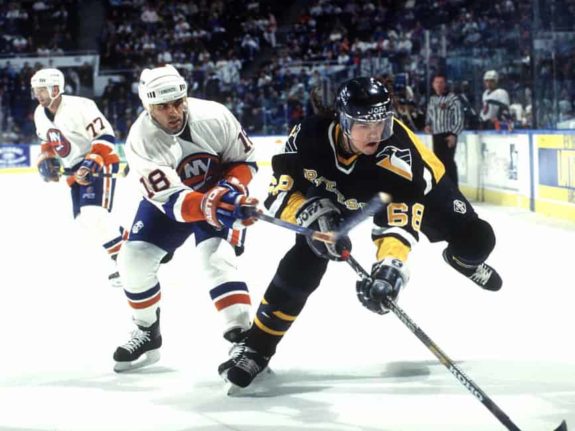Heading into the 2018-19 season, Tampa Bay Lightning fans knew that Nikita Kucherov was primed to have an exceptional year. After posting his first 100-point season in 2017-18 and signing an eight-year, $76-million contract extension, Kucherov looked locked in and ready put on a show.
The Lightning’s star delivered by having, arguably, the single greatest regular season in team history. Not only did Kucherov score 128 points, the most for a Russian-born winger all time, but he also brought home the 2019 Art Ross, Ted Lindsay, and Hart trophies.

After experiencing so much success in a single season, the next logical question is, what will Kucherov do next? Since it would be improbable for him beat his 128-point season, one can expect his point totals to decline in 2019-20. But how far will they fall?
To try and answer this question, let’s look back at recent history to give a frame of reference for Kucherov’s future. Since the 2000 season, three players have broken the 120-point mark. After posting these totals, what did each player do in the following season?
Jaromir Jagr (2000-01 and 2005-06)
First on the list of players who broke the 120-point mark since the 2000-01 season is NHL legend, Jaromir Jagr. For most players, scoring 120-plus points would be a once in a lifetime accomplishment, but Jagr pulled this feat off four times in his career. For this conversation, though, we will only be looking at the 2000-01 and 2005-06 seasons.
In 2000-01, Jagr posted 121 while playing for the Pittsburgh Penguins, averaging 1.49 points a game. The following season, he ‘only’ scored 79 points in 69 games while playing for the Washington Capitals. Despite missing 13 games, he still stayed well above the point-per-game pace, averaging 1.14 points each night.

A few years later, Jagr posted 123 points during the 2005-06 season while playing for the New York Rangers, averaging 1.5 points a night. He followed that up with a 96-point campaign in 2006-07, giving him a 1.17 point-per-game average that season.
When you look at the difference, you will see that Jagr dropped roughly .34 points-per-game the season after his 120-point campaigns (.35 points in 2001-02 and .33 in 2006-07.) While this is due to a number of reasons (injury, aging and joining a new team), it still shows that these truely exceptional players can produce more than a point-per-game even when dealing with difficult situations.
Joe Thornton (2005-06)
Next on the list of players to break 120 points since 2000 is Joe Thornton. During the 2005-06 season, he posted 125 points in 81 games while playing for the Boston Bruins and the San Jose Sharks after a mid-season trade, giving him an average of 1.54 points per game.
Thorton followed up those 125 points by scoring 114 points in the 2006-07 season, averaging 1.39 points each night.
Related: Top 5 Moments of Joe Thornton’s Career
So, the difference between Thornton’s 2005-06 and 2006-07 seasons was a drop of .15 points per game. This was the lowest drop out of the three players profiled, largely due to the fact that Thornton stayed healthy and on the same team the season following his 125-point breakout. These factors allowed him to continue to grow his game, even as teams around the NHL adopted their gameplan to slow him down.
Sidney Crosby (2006-07)
The final player to break 120 points since the 2000-01 seasons is, of course, Sidney Crosby. During the 2006-07 season, Crosby posted 120 points in 79 games, averaging 1.52 points a night.
The 2006-07 was not so kind to Crosby, though, as he only played in 53 games while struggling with injuries. Despite these injuries, he still posted 72 points, averaging 1.36 points-per-game.

Similar to Jagr, injuries stifled Crosby’s follow-up to his 120-point season. Had he stayed healthy, he was on pace to score 111 points and may have even broken the 120-point mark for the second-straight season.
What Does This Mean for Kucherov?
While his situation is different from all three players discussed above, there are a few takeaways you can garner for Kucherov heading into the 2019-20 season. First and foremost, barring injury, he should be able to break the 100-point barrier for the third straight season.
You simply don’t fluke your way to 128 points, and while some dip in scoring is expected, it will likely be closer to what Thornton and Crosby experienced rather than Jagr. Kucherov is surrounded by a cast of players that drove the NHL’s top offense in 2018-19, and he will continue to be a focal point of the offense.

Given this situation, one would expect his total scoring to fall somewhere between .15 to .20 points-per-game. After averaging 1.56 points a night in 2018-19, this would put him closer to the 1.35 to 1.40 range for 2019-20. This would mean Kucherov should score between 110 to 115 points.
Kucherov Should Still Impress in 2019-20
Of course, the NHL is weird sometimes. Kucherov could get injured like Jagr or Crosby, and see his point totals decline due to that. He could play in 82 games and only score 82 points, still an impressive total, but far lower than what one would expect.
Since he is one of the top competitors in the league, though, you really shouldn’t put it past Kucherov to score 120-plus points for the second straight season. He is the type of player that could even break 130 points for the first time in the salary cap era, especially since no one is expecting him to pull it off.
Lightning fans should temper their expectations, and ‘only’ expect a 100 to 110-point campaign from Kucherov. As long as he can stay healthy, there’s really no reason to believe that he shouldn’t hit that high-water mark once again. If he can continue to provide that kind of offensive firepower, Tampa Bay will, once again, be a threat to win their division and be a favorite to win the Stanley Cup.